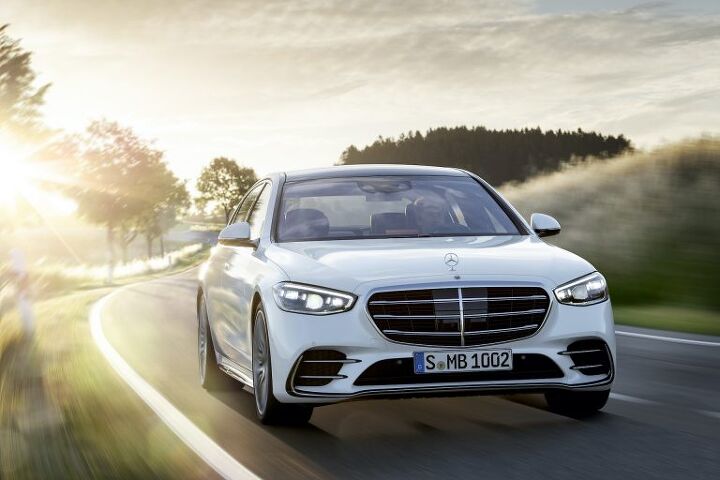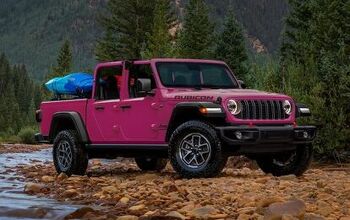Daimler Promises Digital Perfection With 2021 Mercedes-Benz S-Class

The S-Class has always been the sparkling sapphire in Daimler’s crown. The model has historically offered unparalleled luxury and cutting-edge tech that gradually trickles down to the rest of the lineup. It also shows off what Mercedes-Benz is capable of when, running on all cylinders, it sets out to make the best car money can buy without crossing over into obscene extravagance. In this respect, the 2021 S-Class seems to deliver as it always does.
A little larger than its predecessor, the next incarnation of Mercedes’ finest comes in at 208.2 inches long, 76.9 inches wide and 59.2 inches tall. Its extended wheelbase and short overhangs gives it the impression of a smaller vehicle from afar, however. While the manufacturer happily suggests this allowed for an overall increase in the cabin airiness, Daimler admits the model’s technology is what’s supposed to get one salivating — and it did its utmost to make sure it’s omnipresent.
Formerly flush door handles pop out upon your approach above predicable 19-inch wheels (21-inchers if you get the AMG Package), while slick LEDs illuminate the road ahead with a three-dot pattern that matches the triangular tail lamps. The fancy-schmancy luminescence also migrates inside with some of the most ambitious ambient lighting we’ve seen on a production car.
But we need to talk about the rest of the vehicle before going on about the interior. Despite the S-Class never being famous for having the most striking exteriors in the world, the 2021 MY seems to be particularly vanilla. Mercedes is known to be conservative with its designs (most German automakers are), but this model doesn’t seem to move the needle far in either direction. It’s of little consequence, however. No one is going to kick this baby out of their garage because it doesn’t win the beauty pageant in a landslide. Besides, everyone knows it’s what’s on the inside that matters.
In the case of the new S-Class, that will be either the base S500 4Matic’s 3.0-liter straight six (429 hp/384 lb-ft) or the 4.0-liter twin-turbo V8 (496 hp/516 lb-ft) found inside fancier trims. Daimler has opted to make all-wheel drive obligatory on the model, as well as the 48-volt EQ-Boost mild-hybrid system that can add 21 horsepower and 184 lb-ft of torque when requested. Both engines will also be mated to a nine-speed automatic and electronically limited to 130 mph. Luxury Line and AMG Line vehicles have the added benefit of 4.5 degrees of rear-wheel steering, with Executive stretching that angle all the way to 10 inches. Daimler claims the options give the car an impressively small turning circle — less than 36 feet on the Executive.
AMG models and a plug-in hybrid edition are said to be forthcoming. Until then, the 4.0-liter V8 is the most potent powerplant you can buy. However, AMG’s super sedans won’t just amplify how quickly you can burn through a set of stickier tires or (presumably) making it easier to nix that digital speed limiter. They’ll offer enhanced driver assistance features not found on other models. Daimler claims you’ll even be able to enjoy some vehicular autonomy, albeit with the system maxing out at SAE Level 3.
Just the same, the standard equipment remains impressive. The next S-Class will come with driver assistance features like adaptive cruise control that’s functional at any speed, the best active steering and lane-change assist Mercedes has ever put into a car, traffic-sign recognition that helps the car maintain the correct speed, automatic emergency braking, pre-collision assist, cross-traffic assist, parking assist with 360-degree cameras, and just about everything else you’d expect to see on a high-end automobile.
And, when you can’t avoid an accident, the car seems ready to ace the egg-drop test. Mercedes has outfitted the car with sensors that preemptively inflate seat bolsters (to keep you in place) while you’re pushed away from the dashboard moments before impact. Those systems are there to help an already impressive array of inflation points. Fancier trims can also option rear seat airbags that deploy in a tent formation around the occupants. However, that last feature may be limited to European models with a 2×2 seating configuration. U.S.-spec cars all seem poised to seat five at launch, but we should get the system that bounces up one side of the sedan in the event of a T-bone style crash to help mitigate impact force. We’ll just have to wait for MB to fine tune it, as it’s not planned for release until later in 2021.
Mercedes-Benz said it is hard at work improving voice command and gesture controls for the latest version of the MBUX user interface. While we’re big fans of communicating with a car through physical inputs (buttons, levers and knobs), it would be nice to see any automaker make voice/gesture work on a regular basis. Perhaps more helpful is MBUX’s continued integration of the Mercedes Me app, which allows customers to customize the vehicle to suit their needs and offers seven distinct user profiles verified when you give the S-Class your voice authentication, a fingerprint sample, facial recognition scan, or the always easy personal identification number (PIN). There will also be a virtual assistant on hand that you can to do things or simply annoy with trivial questions about the weather.
If you’re like us, however, you’ll probably use the 12.8-inch OLED central touchscreen for most functions. Here, Mercedes said it has boosted processing power by 50 percent and added automated toll payments. Overall, the system looks very Tesla-like, which has its pros and cons.
New S-Class models likewise come with a 12.3-inch digital gauge cluster that can be configured to your heart’s content. The display makes use of driver-facing camera to provide futuristic 3-D effect (which can be turned off in the event of a headache). While the idea of having an on-board camera pointed directly at your nose is a little unsettling, it’s a cool inclusion and really helps the model drive home the whole technology angle. When activated, it creates a massive virtual head-up display (equivalent to 77 inches) and borders on augmented reality when paired with navigational data.
When can you purchase this sumptuous buffet of technology? Daimler says Mercedes-Benz dealerships should start seeing them sometime before next summer. There are still loads of unfinalized features the company plans on rolling out for higher trims as the year progresses, and plenty more we couldn’t include in this article due to the sheer volume of what’s being offered. Speaking of which, since Mercedes is going big with the base S-Class for next year, we doubt it’ll have an MSRP below six figures. If we’re wrong, we estimate the brand will price it around $99,999 and probably not a penny cheaper.
[Images: Daimler]

A staunch consumer advocate tracking industry trends and regulation. Before joining TTAC, Matt spent a decade working for marketing and research firms based in NYC. Clients included several of the world’s largest automakers, global tire brands, and aftermarket part suppliers. Dissatisfied with the corporate world and resentful of having to wear suits everyday, he pivoted to writing about cars. Since then, that man has become an ardent supporter of the right-to-repair movement, been interviewed on the auto industry by national radio broadcasts, driven more rental cars than anyone ever should, participated in amateur rallying events, and received the requisite minimum training as sanctioned by the SCCA. Handy with a wrench, Matt grew up surrounded by Detroit auto workers and managed to get a pizza delivery job before he was legally eligible. He later found himself driving box trucks through Manhattan, guaranteeing future sympathy for actual truckers. He continues to conduct research pertaining to the automotive sector as an independent contractor and has since moved back to his native Michigan, closer to where the cars are born. A contrarian, Matt claims to prefer understeer — stating that front and all-wheel drive vehicles cater best to his driving style.
More by Matt Posky
Latest Car Reviews
Read moreLatest Product Reviews
Read moreRecent Comments
- Lorenzo This car would have sold better if there was a kit to put fiberglass toast slices on the roof.
- Lorenzo The Malibu is close to what the 1955 Bel Air was, but 6 inches shorter in height, and 3 inches shorter in wheelbase, the former making it much more difficult to get into or out of. Grandma has to sit in front (groan) and she'll still have trouble getting in and out.The '55s had long options lists, but didn't include a 91 cubic inch four with a turbo, or a continuously variable transmission. Metal and decent fabric were replaced by cheap plastic too. The 1955 price was $1765 base, or $20,600 adjusted for inflation, but could be optioned up to $3,000 +/-, or $36,000, so in the same ballpark.The fuel economy, handling, and reliability are improved, but that's about it. Other than the fact that it means one fewer sedan available, there's no reason to be sorry it's being discontinued. Put the 1955 body on it and it'll sell like hotcakes, though.
- Calrson Fan We are already seeing multiple manufacturers steering away from EVs to Hybrids & PHEVs. Suspect the market will follow. Battery tech isn't anywhere close to where it needs to be for EV's to replace ICE's. Neither is the electrical grid or charging infrastructure. PHEV's still have the drawback that if you can't charge at home your not a potential customer. I've heard stories of people with Volts that never charge them but that's a unique kind of stupidity. If you can't or don't want to charge your PHEV then just get a hybrid.
- AZFelix The last time I missed the Malibu was when one swerved into my lane and I had to brake hard to avoid a collision. 1 out of 5⭐️. Do not recommend.
- 2ACL I won't miss it; it was decent at launch, but in addition to the bad packaging, GM did little to keep it relevant in the segment. I'd prefer that another domestic automaker doesn't just give up on the mainstream sedan, but unlike some of Ford's swan songs, the Malibu made an indifferent case for why they should live.









































Comments
Join the conversation
WTF is with that dashboard?!
Nice Genesis. It makes a solid argument for buying a big Tesla instead.